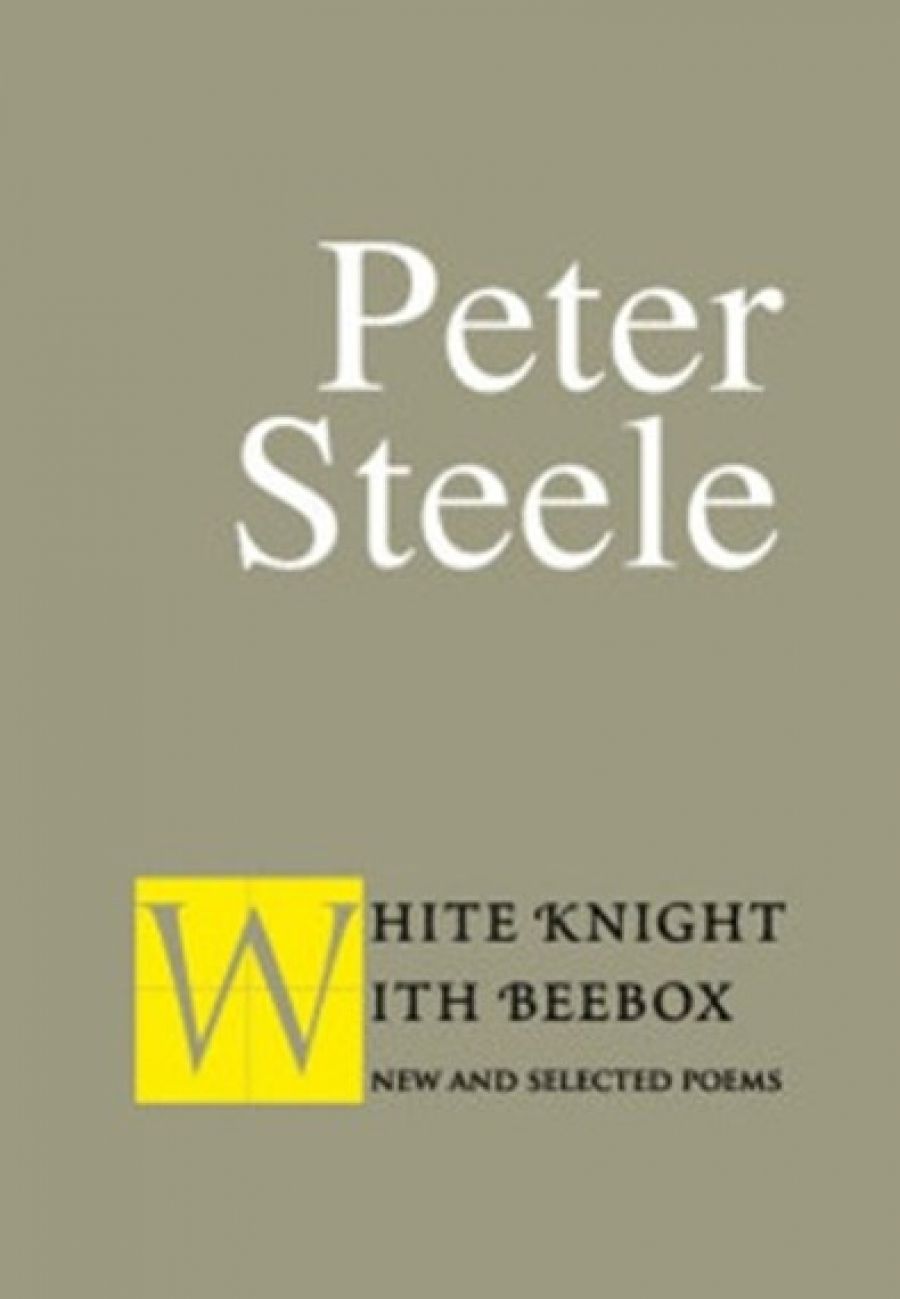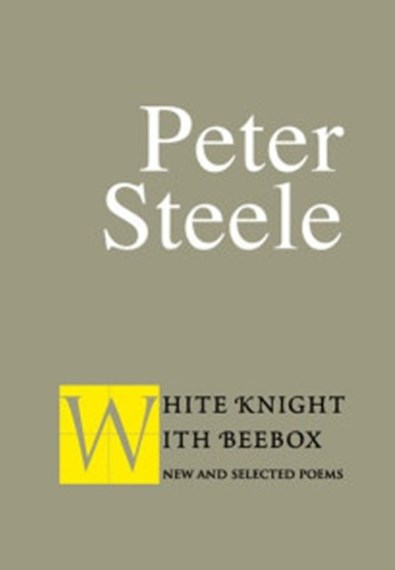
- Free Article: No
- Contents Category: Poetry
- Review Article: Yes
- Article Title: ‘Light as breath itself’
- Online Only: No
- Custom Highlight Text:
There are times when I read a book that reinvigorates important questions for me – such as how language carries and creates meaning, and what, after all, is the function and force of poetry. Usually, such a book is a creative work and I like to imagine that the first readers of volumes by George Herbert or John Donne responded with such questions – to poetry that consistently registered a persuasive complexity and which, while emotionally restrained, carried a pithy emotional charge.
- Book 1 Title: White Knight with Beebox
- Book 1 Subtitle: New and selected poems
- Book 1 Biblio: John Leonard Press, $24.95 pb, 252 pp
- Book 1 Cover Small (400 x 600):

- Book 1 Cover (800 x 1200):

In other countries this poetry, notwithstanding its occasional difficulty and its sometimes clotted textures – which, to mix the metaphor, brings its own cerebral pleasures of un-knotting strands of thought and words – would be widely celebrated. In Australia, where poetry has consistently been marginalised by both public policy and a broad culture with little interest in its own serious literature, Steele’s poetry has mainly been admired by a small circle. I hope that, with the publication of this volume of new and selected poems, many more readers will make its acquaintance.
However, real familiarity with Steele’s work is not a glancing matter. It demands an attentiveness to language and to cultural and spiritual issues. It is highly allusive, challenging the reader to make connections with other books and literatures. Yet one does not need to be fully cognisant of all of Steele’s references to make good sense of the poems, which consistently and persuasively speak of recognisable and important subjects, such as compassion, the preciousness of good ideas, and the complexities and contradictions of history.
Peter Steele is a Jesuit, and this calling and discipline are strongly reflected in his writing. A good number of the poems are driven by a broadly devotional impulse. Many show the poet thinking aloud, following Charles Dickens’s comment, quoted as an epigraph to one of the poems, that ‘An idea, like a ghost, must be spoken to a little before it will explain itself’.
This reminded me that poetry, in its great and various traditions, has been as often used to carry and explore ideas as to convey feelings. It has been digressive as often as it has been concentrated; has chased and courted deeper understanding and broad notions of humanity and civilisation as often as it has pursued and tantalised intense individual emotion; has elaborated as often as it has evoked; has essayed as often as – and usually at the same time as – it has refined.
I was reminded, too, that poets have often been close to the other arts, including music and painting. As far as we know, the T’ang Dynasty poet Wang Wei painted as brilliantly as he wrote and was a fine musician, while Michelangelo constructed complicated sonnets when not producing his paintings and sculptures. Steele, too, engages with music and the visual arts. Many of his poems are ekphrastic: that is, they are inspired by and comment, sometimes indirectly, on particular works of art. Most of the ekphrastic poems were originally published in two superbly illustrated volumes that matched the poems and works of art, and it is good to see a generous selection of them reproduced here, albeit without illustrations of the works which prompted them. As ekphrastic works they are unusually fine; they work beautifully as individual poems. For Steele, art and poetry are, as it were, conjoined in the difficult act of witnessing and transfiguring the world.
His musical sense is largely embodied in the poems themselves. In an era where so-called ‘open’ forms and free verse predominate, at least in English-language poetry – and have, indeed, become so prevalent that many poets never even try the intricate resources of metre, let alone rhyme – Steele’s poetry understands the effects of a broadly metrical cadence and rhythm. His poetry sings as well as speaks; its ways of saying are complex.
In practice, this means that, apart from occasional departures into other forms, including the villanelle, much of his work employs a kind of stress metre of alternating five- and four-beat lines, with a close but varying relationship to iambic pentameter and tetrameter. However, the rhythms of poems are dictated as much by their arguments as by metrical concerns, and the overall effect is various and subtle:
In the end, as at the beginning, here’s the Word,
boxed away in its book, and light
as breath itself, but no wraith, and rising
to eye and ear and mouth. Its tale
of good having the last word is a quaint one,
given the plague and the camps, but I’ll read it,
heart a crosspatch often as not, and mind
losing and finding the way.
(from the ‘Prologue’ to ‘A Mass for Anglesea’)
It is characteristic that in this poem ‘the Word’, with its complicated, glorious and troubling associations, is ‘boxed away’. Steele never forgets that the material things of the world, however humble, are as important as the large abstractions, and coexist with them, helping to make sense of them. It is also characteristic that the story of ‘the Word’ is revealed as problematic; that the poem’s persona both loses and finds the way. For Steele, the speaking out, the inveigling of words into poetry, is part of a larger and unfinished discussion, as much a matter of posing questions as providing answers.
However, Steele’s poetry is not always marked by a high seriousness. In the poem ‘Possum’, he writes: ‘There you go, fast in a long swagger, / cool cat on a hot night, / impenitent and gleaming.’ This is a poem which gains much of its force through a virtuosic tonal and rhythmic control. It runs at the reader with an easy gait and travels swiftly, with complex wit, through to a deceptively simple and resonant conclusion: ‘Small clown, prince of the raw, moron / with blazing eyes, keep watching: / you are not alone.’ Between the opening and closing stanzas, the word ‘fleering’ appears. Like ‘crosspatch’ in the earlier quotation, it illustrates Steele’s love of an unusual, even arcane vocabulary. There is something flamboyant in his use of such words, yet they also add to the poetry’s depth and subtlety. As much as Steele is concerned with the meaning of ‘the Word’, he continually delights and revels in words in the lower case.
Of course, distinguishing between Word and word is perhaps a mistake in considering any poetry of active religious contemplation. In ‘A Mass for Anglesea’, the various parts of the poem are structured according to different parts of the Christian service of the Eucharist. They celebrate, pray for, comment on and debate aspects of humanity, history and belief in terms of ‘the heart’s currents, the ways of flesh and blood / from sarsen-time to now’, and also in terms of an almost Romantic hunger ‘by turns for the great crumb of the world / and for all it cannot be’. One of the themes of this poem is the importance of tolerance and mercy; of forgiving ‘The blundering heart in its mazy wood’.
This is a recurrent theme in Steele’s work. God may, superbly, be ‘Firebird, flambeau, haunter of all that is, / Quick in the foamy pith of the sea-rush here’ – such writing brings a revitalised Gerard Manley Hopkins to mind – but, through Christ, God is also ‘word / and vine both, meaning and fruit displayed // on the world’s lattice, if only the light will hold’. That is, He is both omnipresent and elusive, a presence to be intuited as much as to be understood intellectually.
Christ is also author of a ‘rumouring leaf’, ‘frail with use’. At the end of ‘Word’ – the fifth part of ‘A Mass for Anglesea’, from which these phrases come – the poet characterises himself as ‘blind at best to much about me’, and as trying ‘for a touch of the word’s Braille’. Such images of darkness and light, so central to the Bible and so important to Steele’s poetry, partly function to indicate how uneasy the journey with and towards belief can be. The poems become a path to seeing better how fragile and uncertain – and yet how extraordinary – are the things of the world.
As if to confirm these preoccupations, one of Steele’s ekphrastic poems, ‘Rounds’ – after Diego Velázquez’s brilliant painting of 1618, An old woman cooking eggs – begins with an image of the woman ‘in a comb of light’, then moves to contemplate how ‘the sun’s flail teaches a dullard / Earth how little keeps it from the void’. At the poem’s conclusion, we are left with the idea that the woman and the boy in the painting are ‘tensed a little beyond this moment, / The way nameless, the mind fearless’. This summarises nicely part of Steele’s own quest to say truthfully what lies beyond each momentary experience, and at the same time to honour experience’s actuality and elusiveness.
Discussion of a relatively early work, ‘Dreaming a Poem’, may be a good way to conclude this review, because in it Steele writes of ‘the gift / of exile’ where ‘You cannot find / your way, but it is finding you, / as the dark fields rise to meet you’ and where ‘you borrow your being from change’. This complex poem follows the poet into his immersion in the creative imagination where many boundaries and borders dissolve. It is one of the finest poems I have read about receiving and shaping the poetic impulse.
And one could also call this an agnostic poem, in the sense that it speaks to everyone interested in the transformative processes of art and word. Almost all of Steele’s poetry has such elements, and all can be enjoyed by Christian and agnostic alike, because of its intellectual and verbal fecundity, and because it speaks eloquently of, and embodies, the human need to make sense of complexity and ambiguity and to see more clearly.
There has been a good deal of debate in recent decades about whether religious poetry can stand alone as successful poetry in its own right. Steele’s White Knight with Beebox conclusively answers this question in the affirmative.


Comments powered by CComment